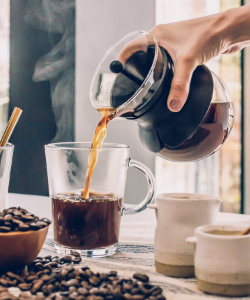For roughly 83% of Americans and many others around the world, the morning is incomplete without a warm cup of coffee in our hands. No wonder we celebrate International Coffee Day each year on September 29. Coffee provides a much needed energy boost, and has also shown to offer many health advantages such as a longer life and lowered risk of Type 2 diabetes! However, despite the fact that the average American spends $1,110 a year to fuel this caffeine habit, many of us take very little notice of where our coffee comes from and where the waste is going. Join us in exploring how you can have your coffee and save the world too!
Bags of Beans
When purchasing coffee grounds or beans, it is often unclear which bags are the most environmentally conscious. We look for phrases on our labels to indicate where and how our coffee was grown in order to make assumptions about its sustainability. We may also look at the price, assuming that a higher cost means a more sustainable product. This is not always the case. Here are a few labels that can help you sort through your beans to find the best green brand for you:
 Bird Friendly Certified
Bird Friendly Certified
- Despite the unusual name, “bird friendly” is one of the best labels your coffee can have. Designated by the Smithsonian Migratory Bird Center (SMBC), this certification indicates ethical and sustainable farming practices. The coffee comes from family farms in Latin America. Instead of clear-cut fields, the coffee from these farms is grown under a canopy of tall trees, providing shelter and food for local and migratory birds, as well as shade for farm hands.
- If you weren’t aware, your Akron Zoo is a co-sponsor of the AZA’s SAFE (Saving Animals From Extinction) program for North American Songbirds. This program was recently the recipient of an AZA grant to promote bird-friendly coffee to protect North American Songbirds. The project, called "Proudly Serving Biodiversity: Unifying the AZA to Demand Bird Friendly Coffee," will allow us to support migratory birds by educating the public about bird friendly coffee growing practices, and by serving this coffee at AZA member institutions, like your Akron Zoo!
- USDA Organic Certified
- Though “organic” is often tossed around in marketing, only coffee with the official seal is held to specific regulations. USDA Organic coffee is examined regularly by government-certified inspectors. The beans are grown without the use of synthetic pesticides and are spaced far enough from other fields using pesticides to avoid contamination through runoff.
- UTZ Certified
- As part of the Rainforest Alliance, UTZ Certified coffee has strict standards for “people, planet, and profit.” This certification means each farm efficiently uses water and energy, manages waste effectively, promotes ecological diversity, protects nature, protects forests and endangered species, reduces and prevents soil erosion and takes measures to adapt to climate change. They also partner with farmers for safe working conditions and fair wages.
Brew from Home
Not only is your choice of coffee beans an important decision for the environment, but so is your method of brewing. Here are a few suggestions for the at-home baristas in all of us:
 (Don’t) Throw out the single-use capsules
(Don’t) Throw out the single-use capsules
- While Keurig may be a convenient solution for a quick cup, those little plastic capsules can pile up fast. Consider switching to a reusable single-serving cup. You will save space in your cabinets, and divert plastic from the landfill. There are also reusable filter options for your regular coffee pot to cut back on your paper filter consumption.
- Cut the cord
- Coffee pots harness 750 to 1200 kWh annually. You can lower that energy consumption by turning off your coffee maker as soon as your brew is done. To use even less energy, you might consider using a french press instead of an automatic coffee maker, using a hand grinder for beans instead of electric or even switching to cold brew.
- Reuse your grounds
- Coffee grounds make a great garden fertilizer for keeping your garden happy and healthy. If you are crafty, there are also several soap recipes that use coffee grounds as an exfoliant. Your neighborhood may also have dedicated coffee recycling facilities. Bio-Bean and Coffee Recycling Co. are just two examples of organizations that repurpose coffee grounds to dye fabric, create alternative fuels and compounds, and to add insulating properties to construction materials.
Out for Joe
Not everyone has time to brew their own coffee, but even when you are going out to grab a cup, there are still ways to be sustainable:
 Buy less
Buy less
- Buying fewer cups of coffee is the easiest way to cut back on waste, especially if you are a daily coffee drinker. Trade a few days at your local coffee shop for a few days of home brew, or lower your caffeine intake by skipping a day or two a week. Your pocketbook will thank you and so will the planet!
- Dispose of the disposables
- One cup of coffee a week is 52 cups in the landfill each year (and if we are honest, many of us drink more than one cup a week). Some coffee houses are happy to put your coffee in a reusable cup you bring in, while others have compostable cups that are quicker to break down once they have been thrown away. You can also skip the plastic straws, plastic stirrers and individually wrapped creamers to help divert even more trash from the landfill!
- Leave corporate; buy local
- Many coffee moguls employ unsustainable deforestation practices in order to expand their coffee bean fields. By buying local, not only are you supporting small businesses, but you are encouraging sustainable farming.
So cheers to coffee! Thanks for helping us start the day on the right foot, both for ourselves and for the environment!
